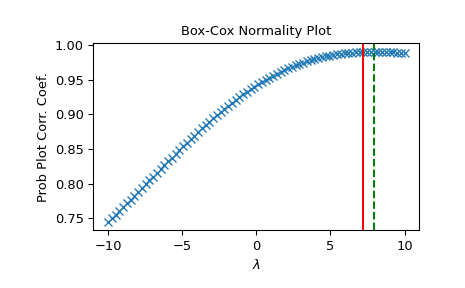scipy.stats.boxcox_normmax¶
-
scipy.stats.boxcox_normmax(x, brack=- 2.0, 2.0, method='pearsonr')[source]¶ Compute optimal Box-Cox transform parameter for input data.
- Parameters
- xarray_like
Input array.
- brack2-tuple, optional
The starting interval for a downhill bracket search with optimize.brent. Note that this is in most cases not critical; the final result is allowed to be outside this bracket.
- methodstr, optional
The method to determine the optimal transform parameter (
boxcoxlmbdaparameter). Options are:- ‘pearsonr’ (default)
Maximizes the Pearson correlation coefficient between
y = boxcox(x)and the expected values foryif x would be normally-distributed.- ‘mle’
Minimizes the log-likelihood
boxcox_llf. This is the method used inboxcox.- ‘all’
Use all optimization methods available, and return all results. Useful to compare different methods.
- Returns
- maxlogfloat or ndarray
The optimal transform parameter found. An array instead of a scalar for
method='all'.
See also
Examples
>>> from scipy import stats >>> import matplotlib.pyplot as plt >>> np.random.seed(1234) # make this example reproducible
Generate some data and determine optimal
lmbdain various ways:>>> x = stats.loggamma.rvs(5, size=30) + 5 >>> y, lmax_mle = stats.boxcox(x) >>> lmax_pearsonr = stats.boxcox_normmax(x)
>>> lmax_mle 7.177... >>> lmax_pearsonr 7.916... >>> stats.boxcox_normmax(x, method='all') array([ 7.91667384, 7.17718692])
>>> fig = plt.figure() >>> ax = fig.add_subplot(111) >>> prob = stats.boxcox_normplot(x, -10, 10, plot=ax) >>> ax.axvline(lmax_mle, color='r') >>> ax.axvline(lmax_pearsonr, color='g', ls='--')
>>> plt.show()

